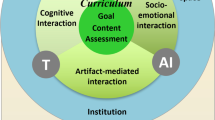Abstract
This exploratory study examines the impact of a collaborative inquiry- and design-based afterschool program on urban high school students’ IT/STEM learning—using information technology (IT) within the context of science, technology, engineering, and mathematics (STEM). The study used a mixed methods design, involving 77 participants within two cohort groups, each participating in an eighteen-month intervention period. Data were collected from the pre- and post-surveys, analysis of the participants’ IT/STEM projects, external evaluation reports, and follow-up interviews. Findings indicate that the program had a significant impact on students’ technology and IT/STEM skills, frequency of technology use, and understanding of IT use in STEM-oriented fields. Some degree of impact on attitude changes toward IT/STEM and career aspirations in these fields was also in evidence. The study demonstrates that IT/STEM experiences supported through technology-enhanced, inquiry- and design-based collaborative learning strategies have significant impact on urban high school students’ IT/STEM learning. Effect of afterschool programs on attitude changes and IT/STEM-related career aspirations of urban high school students are recommended areas of further investigation.

Similar content being viewed by others
References
Barab SA, Duffy TM (2000) From practice fields to communities of practice. In: Jonassen D, Land S (eds) Theoretical foundation of learning environments. Lawrence Erlbaum Associates, Mahwah, pp 25–56
Brown JS, Collins A, Duguid P (1989) Situated cognition and the culture of learning. Educ Res 18(1):32–42
Bruce BC (2003) Literacy in the information age: inquiries into meaning making with new technologies. International Reading Association, Newark
Cole M (1996) Cultural psychology: a once and future discipline. Harvard University Press, Cambridge
Dawsey CP (October 20, 2011) Detroit public schools hits enrollment goal. Detroit Free Press, Detroit
Edelson DC (2001) Learning-for-use: a framework for the design of technology-supported inquiry activities. J Res Sci Teach 38(3):355–385
Friedman T (2006) The world is flat: a brief history of the twenty-first century. Farrar, Straus and Giroux Publishing, New York
Gay LR, Mills GE, Airasian P (2006) Educational research: competencies for analysis and applications, 8th edn. Pearson Education, Inc, Upper Saddle River
Harel I (1991) Children designers. Ablex, Norwood
Harel I, Papert S (1991) Constructionism. Ablex, Norwood
Kane TJ (2004) The impact of afterschool programs: interpreting the results of four recent evaluations. William T. Grant Foundation, New York
Lavy J, Wegner E (1991) Situated learning: legitimate peripheral participation. Cambridge University Press, Cambridge
Marsden E, Torgerson CJ (2012) Single group, pre- and post-test research designs: some methodological concerns. Oxf Rev Educ 38(5):583–616
Mendoza EM, Johnson KO (2000) Land of plenty: diversity as America’s competitive edge in science, engineering and technology. Report of the congressional commission on the advancement of women and minorities in science, engineering and technology development. Retrieved 8 May 2011, from http://www.nsf.gov/pubs/2000/cawmset0409/cawmset_0409.pdf
Mishra P, Koehler MJ, Zhao Y (2006) Communities of designers: a brief history and introduction. In: Mishra P, Koehler MJ, Zhao Y (eds) Faculty development by design: integrating technology in higher education. Information Age Publishing, Charlotte
Mrozowski J (June 4, 2008) Report: Detroit’s graduation rate ranks last among big cities. The Detroit News, Detroit
National Center for Women in Information Technology (2007) NCWIT scorecard: a report on the status of women in information technology. Retrieved 8 May 2011, from http://www.ncwit.org/sites/default/files/resources/scorecard2010_printversion_web.pdf
National Center for Women in Information Technology (2009) Women in IT: the facts. Retrieved 28 Oct 2012, from http://www.ncwit.org/sites/default/files/resources/ncwit_thefacts_rev2010.pdf
National Governors Association and Council for Competitiveness (2007) Innovation America: a partnership. Retrieved 01 May 2007, from http://www.nga.org/files/live/sites/NGA/files/pdf/0702INNOVATIONPARTNERSHIP.PDF
National Research Council (2011) Successful K-12 STEM education: identifying effective approaches in science, technology, engineering, and mathematics. Committee on highly successful science programs for K-12 science education. Board on science education and board on testing and assessment, division of behavioral and social sciences and education. The National Academies Press, Washington
National Science Board (2010) Preparing the next generation of STEM innovators: identifying and developing our nation’s human capital. Retrieved 15 Oct 2012, from http://www.nsf.gov/nsb/publications/2010/nsb1033.pdf
Parker C, Malyn-Smith J, Reynolds-Alpert S, Bredin S (2010) The innovative technology experiences for students and teachers (ITEST) program: teachers developing the next generation of STEM talent. J Technol Teach Educ 18:187–201
Pollock L, McCoy K, Carberry S, Hundigopal N, You X (2004) Increasing high school girls’ self confidence and awareness of CS through a positive summer experience. In: Proceedings of the 35th SIGCSE technical symposium on computer science education. Retrieved 3 Jan 2013, from http://doi.acm.org/10.1145/971300.971369
Scott C (2012) An investigation of science, technology, engineering and mathematics (STEM) focused high schools in the U.S. J STEM Educ 13(5):30–39
Songer N, Lee H, Kam R (2002) Technology-rich inquiry science in urban classrooms: what are the barriers to inquiry pedagogy? J Res Sci Teach 39:129–143
STEM fields (n.d.). In: Wikipedia. Retrieved 8 May 2013, from http://en.wikipedia.org/wiki/STEM_fields#cite_note-nsf.gov-5
Subotnik R, Rayhack K, Edmiston A (2006) Current models of identifying and developing STEM talent: implications for research, policy and practice. Retrieved 8 May 2011, from http://www7.nationalacademies.org/cfe/Rena%20Subotnik%20Think%20Piece.pdf
The American Competitiveness Initiative (2007) Retrieved 8 May 2011, from http://www.whitehouse.gov/administration/eop/ostp
Vygotsky LS (1978) Mind in society: the development of higher psychological processes. Harvard University Press, Cambridge, MA
Acknowledgments
The study reported in this article is based on a project being funded by the National Science Foundation (NSF) through Innovative Technology Experiences for Students and Teachers (ITEST) program (Project Award #: 0737326).
Author information
Authors and Affiliations
Corresponding author
Appendices
Appendix 1: Pre-Program Student TECHNOLOGY USE Survey



Appendix 2: Student QUESTIONNAIRE About Science, Technology, Engineering, and Mathematics


Rights and permissions
About this article
Cite this article
Duran, M., Höft, M., Lawson, D.B. et al. Urban High School Students’ IT/STEM Learning: Findings from a Collaborative Inquiry- and Design-Based Afterschool Program. J Sci Educ Technol 23, 116–137 (2014). https://doi.org/10.1007/s10956-013-9457-5
Published:
Issue Date:
DOI: https://doi.org/10.1007/s10956-013-9457-5




